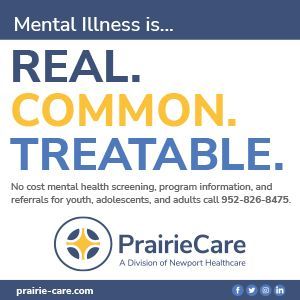pioid and substance use continues to be a challenge for patients and families throughout the United States. In addition to its societal effects, opioid and substance use also results in substantial utilization of health care resources up to and including hospitalization.
Public Health
The Hennepin County SUD Dashboard
A data-driven response to the opioid crisis
BY Tyler Winkelman, MD, and JULIE BAUCH MS, RN
In June of this year, the Minnesota Electronic Health Record (MN EHR) Consortium and Hennepin County launched a new data dashboard, called the SUD Dashboard, to monitor the opioid and substance use crisis in Hennepin County. This interactive, online data report shows substance-involved emergency and hospital visits – or patient encounter data - of Hennepin County residents, using near real-time electronic health record data, updated monthly.
Public health, human services, health care community-based organizations, researchers, policymakers and others can use this data to identify emerging trends, help target lifesaving interventions, or for use in resource allocation, and policymaking.
The dashboard shows the near real-time impact of the substance use crisis in Hennepin County hospitals. It can be used to identify emerging trends like the rise in opioid overdoses or to confirm that methamphetamine use is of concern. It will also be useful in evaluating interventions and investments in resources in a timelier manner. The dashboard - referred to as the SUD dashboard or “substance use disorder dashboard,” is a product of the EHR Consortium. Hennepin Healthcare and Hennepin County have been key partners in the development, analysis and maintenance of the SUD dashboard, providing funding and subject matter expertise to support the work.
Troubling trend that is expected to continue.
“Our goal is for the dashboard to become a common source of truth for having action focused conversations to address the epidemic of substance use in Hennepin County,” said Lolita Ulloa, Hennepin County Director of System Design. “To our knowledge we are the first county in the United States to share near real-time, local data to address the substance use crisis.”
The SUD dashboard displays the current status of the substance use crisis, including what substances are bringing people to the hospital by age, gender, race and other demographic characteristics. The dashboard is updated regularly and serves as a vital reference material for future work in many areas related to responding to the opioid crisis.
Data suggest that July has historically brought the highest level of substance related health care use in Hennepin County. The SUD dashboard is showing that there’s already a marked increase in emergency department visits and hospital admissions related to opioids and psychostimulants, for 2023. It’s the sincere hope that the dashboard will spur upstream prevention, and prevent overdoses and deaths in Hennepin County.
About the EHR Consortium
The Minnesota Electronic Health Record Consortium is a partnership between Minnesota health systems and public health agencies that provides timely and granular data to inform the real-time actions of policymakers, health system leaders and researchers. It focuses on informing health policy and practice through comprehensive data and collaboration. Started in March 2020, the group began meeting with the goal of collaborating to study the epidemiology of chronic conditions affecting Minnesotans. The MN EHR Consortium provided robust information on health equity indicators (e.g., gender, race, ethnicity, rurality, language, age and other important social determinants of health) related to COVID-19, substance use disorders, and other chronic conditions such as cardiovascular disease and hypertension.
The substance abuse disorder (SUD) dashboard is a product of the MN EHR Consortium. Minnesota health care professionals from Allina Health, CentraCare, Children’s Hospitals and Clinics of Minnesota, Essentia Health, M Health Fairview, University of Minnesota, HealthPartners, Hennepin Healthcare, Mayo Clinic and Mayo Clinic Health System, and North Memorial Health, Sanford Health and the Minneapolis VA Health Care System joined forces to explore solutions with a focus on collaboration vs. competition. Minnesota Community Measurement and the Minnesota Department of Health (MDH) were also instrumental in supporting the MN EHR Consortium.
Robust information on health equity indicators (e.g., gender, race, ethnicity, rurality, language, age and other important social determinants of health) related to COVID-19 were collected by participants in this unique, data-driven partnership of health care professionals, researchers and leaders from Minnesota health systems and statewide health care to inform near real-time public health needs about COVID-19 trends. The value of this reporting during COVID-19 contributed to successful outcomes, like being able to identify what populations were at risk and where vaccination sites were needed.
Data privacy and protecting each patient’s private health information is a priority within this construct. Individual patient records are not shared between consortium members; rather, each participating health care system prepares a summary report that represents a snapshot of its own patient population relevant to the topic. These de-identified reports are then sent to a central site for aggregation.
Moving beyond COVID-19, the MN EHR Consortium continues to answer research and population health questions of interest, using its focus and methodology to provide critical and timely data related to a variety of chronic conditions, including substance use disorders. Other applications for the consortium’s model continue to be assessed and applied to address emerging trends; for example, the rise in fentanyl use or to track trends in methamphetamine use.
During the pandemic, while health care systems were doing what they could to mitigate the spread of COVID-19 and care for patients, substance abuse in the community increased. In the midst of managing the public COVID-19 emergency, the alarming opioid epidemic and its multifaceted impact on the community was clearly growing. This prompted officials to develop the Hennepin County Opioid Epidemic web page offering resources – like addiction help, overdose response, and safe storage and disposal of medications.
Hennepin County often works closely with Hennepin Healthcare and was familiar with the MN EHR Consortium’s data resources. A conversation started around exploring the usage of the already established MN ERC to better understand the rapidly growing opioid epidemic in Hennepin County. One identified goal was to add relevant, county-specific data to the Opioid Epidemic web page. They quickly identified the metrics likely to be of interest to researchers, official and the public and worked to develop the SUD dashboard using the Hennepin Count specific health care systems – Allina, HealthPartners, Hennepin Healthcare, M Health Fairview, North Memorial and Veteran’s Administration. They continue to partners on analysis and dashboard maintenance, providing funding and subject matter expertise to support the work.
Dashboard Users, Features, and Impact
Public health, human services, health care – including physicians – as well as community-based organizations that serve clients struggling with substance use—can use the dashboard to inform their activities and investments. Journalists can use the SUD ashboard to keep their fingers on the pulse of the opioid epidemic in Hennepin County.
Hennepin County is believed to be the first county in the United States to offer this type of publicly available, regularly updated data.
The SUD dashboard displays the current status of substance use in Hennepin County, including what substances are bringing Hennepin County residents to the hospital by age, gender, race and other demographic characteristics. Of concern, the SUD dashboard shows a marked increase in emergency department visits and hospital admissions in 2023 related to opioids and psychostimulants, like methamphetamine: a troubling trend that is expected to continue.
The dashboard shows what’s happening now, and what happened in the past. It is updated monthly, providing near real-time data to interested stakeholders and the public. This robust, longitudinal data provides important insights, which can help identify emerging trends in substance use. This allows policy makers, specifically at the county level, the flexibility in addressing emerging substance use trends with prevention tactics. The recent legalization of adult use cannabis in Minnesota, as of August 1, 2023, provides a timely example. The SUD dashboard will soon be able to provide insights into cannabis use, pre-versus postlegalization for people accessing Hennepin County health care systems.
There are a variety of options to sort these data on the SUD dashboard. Substance-involved emergency and hospital visits in Hennepin County can be sorted by year, substance (opioids, alcohol, cannabis, etc.), and whether a non-fatal overdose was the primary reason for the visit, or if the primary reason for the visit was something else and substance use was noted in the EMR by the provider. Users can refine data by selecting several demographic categories.
Definitions
Opioid-related deaths include all deaths where any type of opioid (natural, synthetic or in combination) was a cause, or contributing cause of death and are not limited to overdose deaths. However the vast majority of opioid-related deaths are overdose deaths. Death data is for residents only. Geographic data is by residence of the deceased, not place of death. For statistics on place of death and deaths occurring within Hennepin county (regardless of residence of the deceased), contact the Hennepin County Medical Examiner’s office. Death rates per 10,000 people are calculated by dividing death totals by Census Bureau population estimates for each year, 2011 to present. Fentanyl is identified from cause-of-death descriptions. Methamphetamine is identified from ICD-10 codes. Data for Hennepin County is compiled according to methodology developed by the Hennepin County Department of Public Health and are considered official counts. Data from other counties may not match figures from the Minnesota Department of Health and should not be considered official. Please contact MN MDH for official opioid-related information.
Beyond tracking metrics related to overdose and hospitalizations, the guiding principles of the work have developed several strategic responses to the crisis. While this work is collectively an ongoing project, many supportive tools and reports have been generated. To date, some of the responses have included:
Prevention
- Developed an opioid data collection and sharing tool
- Supported and obligated providers to use best practice prescribing guidelines
- Promoted safe storage and environmentally-sound disposal
Response
- Ensured all first responders, necessary county employees and targeted stakeholders have access to and training to administer naloxone
- Coordinated two county-operated safe syringe services and naloxone distribution
Treatment and recovery
- Implemented substance use disorder (SUD) reform in Hennepin County
- Sought new state and federal opioid grant opportunities
- Ensured contracts have medications for opioid use disorder (MOUD) accommodations
- Increased treatment options (MOUD) and transition planning in correctional settings and throughout county clinical settings
Eliminating disparities
- Increased external and internal substance use disorder (SUD) data infrastructure
- Launched multi-year contracts with community organizations that provide culturally relevant response and prevention services to American Indian, African American, unsheltered homeless, and Somali/East African communities
Stakeholders of the Hennepin County Opioid Initiative can use these reports as a single source of truth regarding opioid deaths in Hennepin County. Results are designed to be used to improve success in reducing deaths and to look for opportunities to target services. In our work, only Hennepin County values are considered official values. Values for other Minnesota locations are available through the Minnesota Department of Health. Official death figures are updated in September/October when this data comes back from the Centers for Disease Control.
Access the SUD dashboard at: hennepin.us/opioid.
Tyler Winkelman, MD, is director of the general internal medicine division at Hennepin Healthcare and leads the SUD dashboard project for the MN EHR Consortium.
Julie Bauch MS, RN, is the Hennepin County opioid response coordinator.
MORE STORIES IN THIS ISSUE
cover story one
The Minnesota CANDOR Act: Addressing adverse events
By Nels E. Dyste
cover story two
Unveiling the Future: Artificial Intelligence in Spine Surgery
By Omar Ramos, MD


















